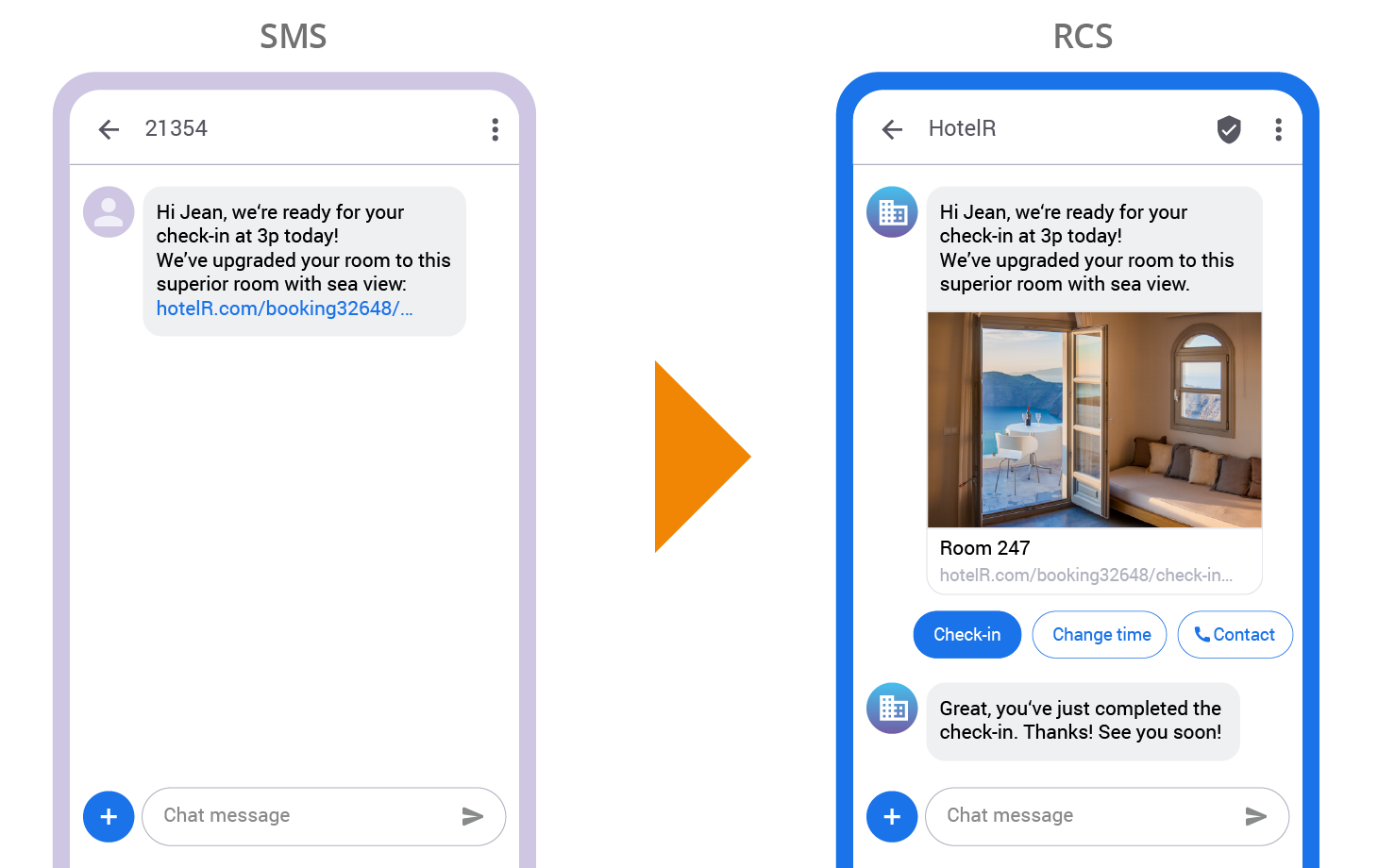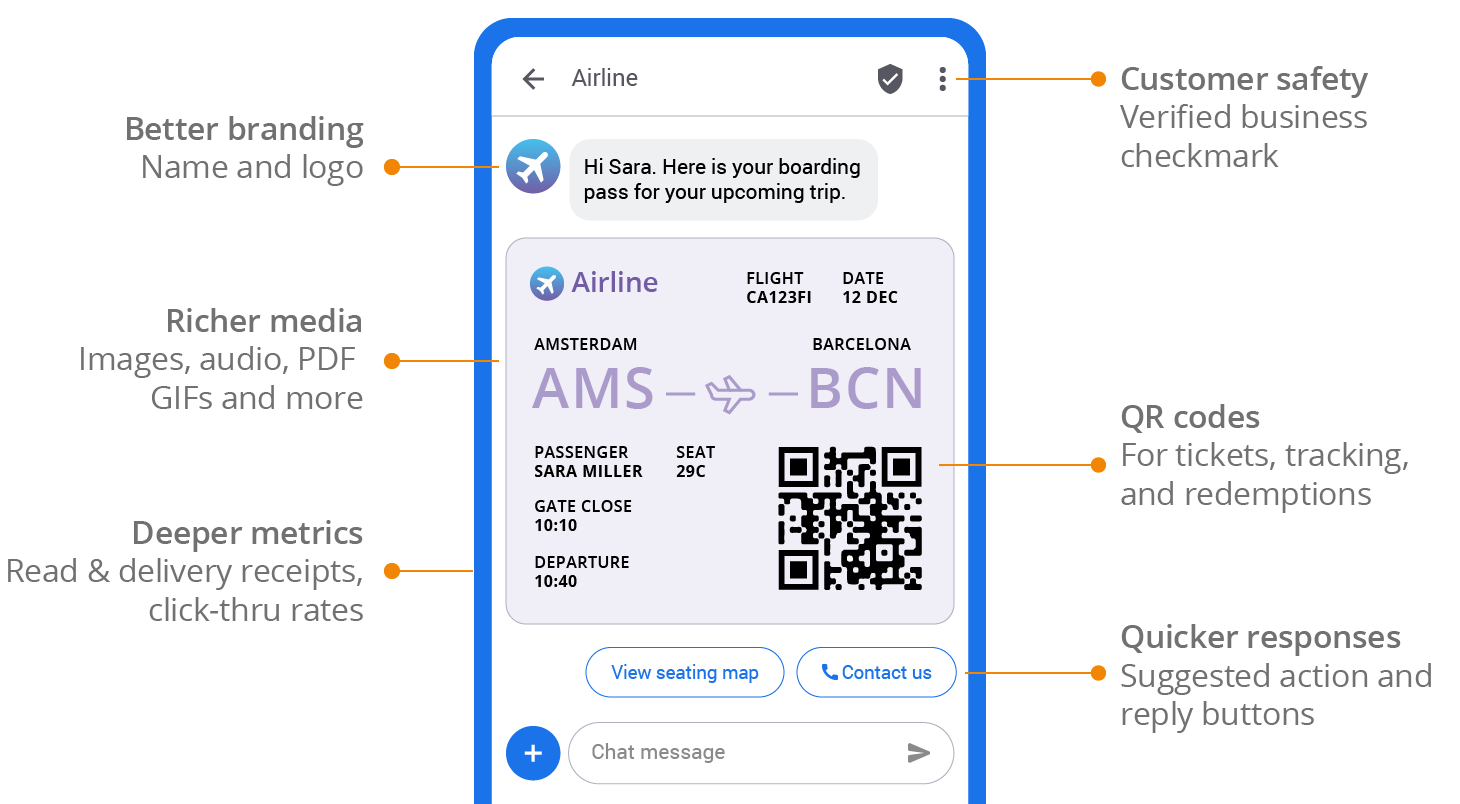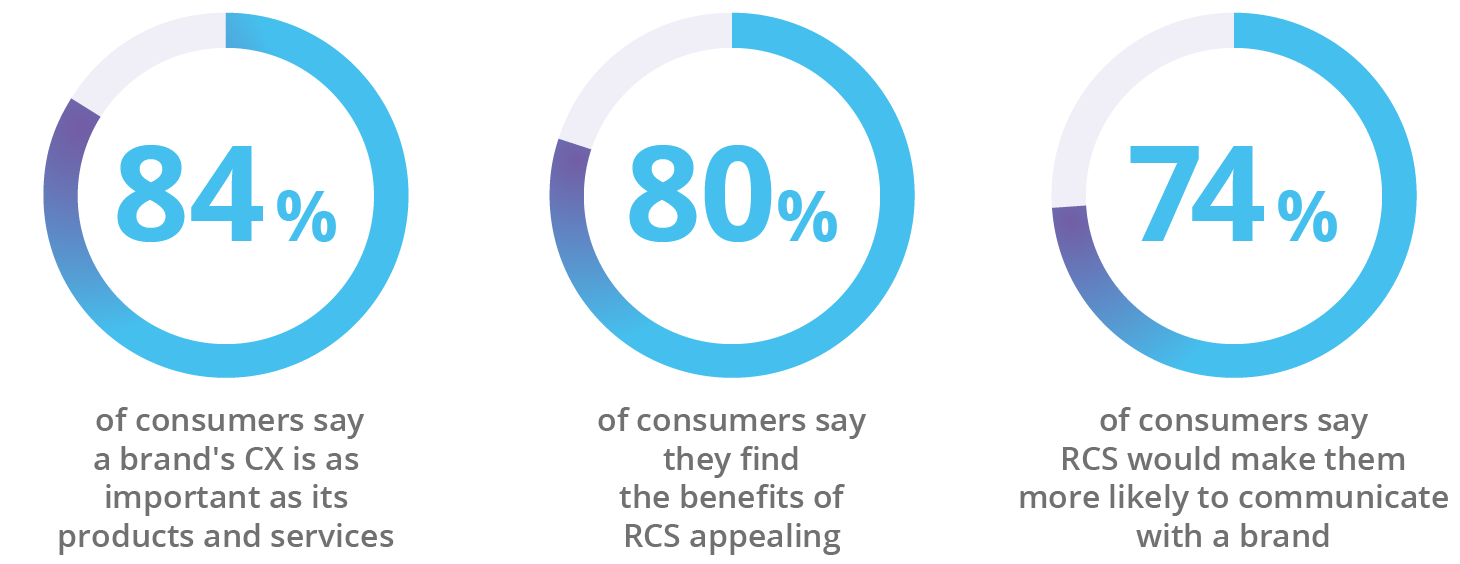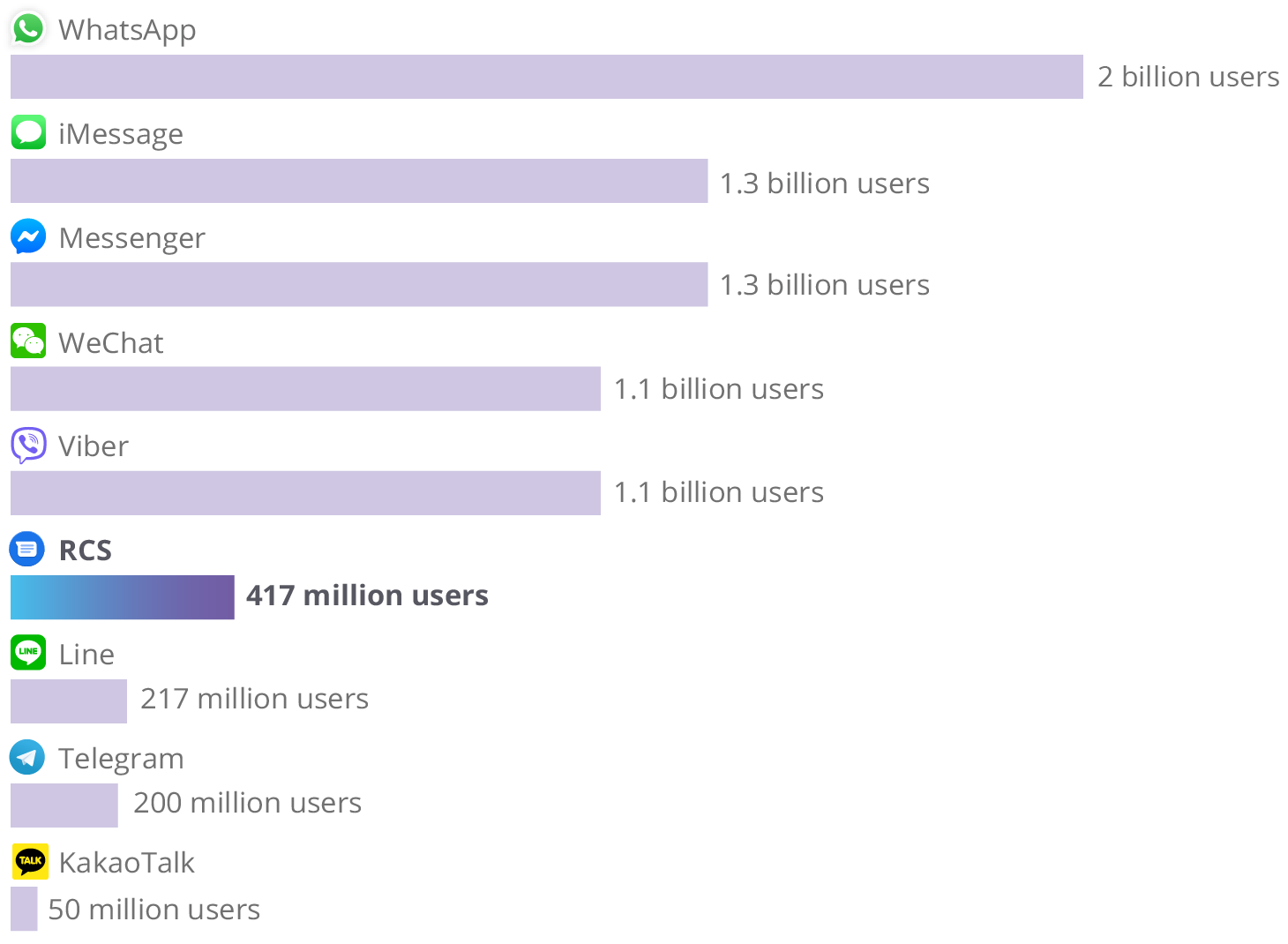RCS Business Messaging: Everything Enterprise Needs to Know About the Next Gen Messaging Service

While today’s consumers demand smart 1:1 conversations featuring rich media, many brands still rely on old school technologies such as email and SMS to communicate with their customers: Here’s how texting’s successor, Rich Communication Services (RCS), can bridge that divide.

Smartphone users could be forgiven for thinking that SMS is now irrelevant as they migrate to chat apps in their millions to communicate socially and professionally. But behind the scenes, that basic 160-character messaging service is still plugging coverage gaps to help users stay connected — even if they don’t realize it. For instance, it’s thanks to SMS that Apple’s iMessages can be delivered to Android phones.
While relying on SMS to mainly deliver notifications and One Time Passwords, savvy brands are moving past its limitations — and those of email, letters and voice calls too. Instead, they are increasingly conversing with customer bases over chat apps (what the industry calls ‘over-the-top’ messaging apps), leveraging the immediacy, modern UX and rich media options of, say, WhatsApp, to deliver great customer experiences, and to deliver on marketing strategies.
While this shift to chat apps is proving highly effective for driving 1:1 conversational commerce, there is a risk: The creation of chat app silos that sees marketers and CX specialists struggling to implement consistent brand experiences across multiple touchpoints and channels. In turn, this can lead to the fragmentation of marketing strategies, and a reduction in ROI.
Why RCS has the potential to be a universal chat app
Now enter SMS’s successor, Rich Communication Services (RCS). It delivers all the comparable features and functions of third party chat app but retains SMS’s inherent strengths by giving users access to a universal, native app that will come pre-installed on their smartphone. This universality is critical as it means, just like SMS, RCS will be the default messaging app as soon as a user boots up their new phone.
And like SMS, RCS’s services are set to be delivered directly via mobile operator cellular networks across the world. Uptake from RCS’s key stakeholders has been strong to date: 89 global operators have launched RCS in 60 countries with 136 operators expected on board by the end of the year.
Handset makers such as Samsung and Huawei have also signed up as well as mobile OS providers including Google (see Google It below). Combined, they are working towards creating an interconnected global service that delivers a consistent messaging service to 5 billion unique mobile subscribers.
However, issues do remain. Critically, while many telcos are deploying the service, and pilots and localized real-life tests are yielding successful results, the industry is still struggling to deliver the global standardized service required to deliver true universal coverage. Thankfully, key stakeholders are already working on solutions to overcome these and other potential barriers to success (see “growing pains” section below). If and when these issues are dealt with, RCS has the potential to replace its predecessor while addressing traditional texting’s many limitations to facilitating brand-to-consumer interactions — from character restrictions and zero branding functionality to a lack of analytics – all while offering rich chat app-like functionality without creating silos.
To learn about the technologies and tools needed to chat with customers on their preferred channels, explore tyntec’s conversations API here.

Why RCS Business Messaging is a game changer
For enterprise, this is good news because running alongside the consumer rollout of RCS is RCS Business Messaging (RBM). It offers all the functionality of chat apps but without the risk of creating silos, or requiring app-fatigued customers to download and sign up to yet another messaging platform. Critically, RBM offers a rich set of CX and marketing capabilities to leverage:
Better branding
Company names and logos appear in the text with verified business checkmarks (instead of random numbers), offering greater peace of mind for spam-weary consumers.
Richer media
Companies using RBM have full access to all the rich media capabilities of third party messaging apps. These include images (think carousels), GIFs, audio, PDFs (say, for catalogues), and much more.
Deeper metrics
RBM enables business to deep dive into analytical data and metrics, including all important read receipts, click-thru rates, and even when the customer begins typing a reply. According to the Harvard Business Review, such functionality is essential as 82% of organizations say better data, including read receipts, are the most important capabilities of any advanced messaging app.
Greater automation
As with OTT chat apps such as WhatsApp, advanced AI-powered chatbots can be integrated with RBM. These can be used to address typical customer requests effortlessly, while more complex inquiries can be handed over to live agents in an instant.
Quicker responses
RBM’s suggested action buttons combined with quick button replies simplify customer journeys, which is becoming ever more critical in this customer-centric era: Salesforce’s State of the Connected Customer Report reveals that 84% of consumers say a brand’s customer experience is as important as its products and services.
Such a diverse suite of functionality is already being met with approval by consumers too. According to GMSA’s RCS Business Messaging research study, nearly 80% of consumers say they find the benefits of RCS appealing, while 74% state RCS would make them more likely to want to communicate with a brand.
Pilot testing success
RBM’s increased functionality is already proving invaluable to customer engagement and experiences in pilot tests:
Customer journeys covered
The home goods online retailer Overstock.com is leveraging RBM to allow customers to view purchases, shipping, and delivery confirmations. Once an order has been received, consumers can also quickly rate their purchase, and reach out to customer services quickly if they need assistance; all this without the need for the consumer to download and boot up a separate chat/e-commerce app, or be redirected to the company’s website.
Conversion rates boosted
Global food chain Subway has been testing RBM’s rich media capabilities for promotions. Previously relying on SMS to deliver promos, the food chain discovered that RBM messages featuring images boosted conversion rates by 140% when compared to standard texts.
Customer conversations created
Investment bank Citi is deploying RBM in conjunction with a chatbot to allow customers to check up on, say, their current balance or any payment due dates. Critically, they can escalate any inquiry to a live agent as and when they choose to.

Those are all RBM’s top-line benefits — so what are the catches?
While the new service’s benefits are substantial, there are roadblocks that need to be cleared before RCS Business Messaging can become synonymous with delivering optimized conversational commerce and great CX:
Growing pains
While RCS itself is gaining traffic share thanks to increased operator and handset support, Juniper Research suggests that worries remain about operators delivering RCS offerings that not only interconnect with each other, but are also fully compliant with the GSMA’s Universal Profile tech specifications (an industry-agreed set of features and technical enablers for RCS deployment). These problems combined with slow smartphone update cycles might impact on RCS’s future adoption and traffic rates if not addressed fully.
Google it
While there are definite signs that key industry players are committed to resolving interoperability and compatibility issues, Google has stepped in over the past year to speed up RCS adoption. Instead of relying solely on carriers to coordinate and deliver the service, Google is rolling out RCS chat as part of its Messages app to more and more countries, starting with the UK, France and USA.
This means select Android users can start accessing the next gen texting service now rather than later. Combined, such an approach means RCS will become available sooner to consumers, and in turn enable brands to begin leveraging RCS Business Messaging more effectively, and at greater speed.
Stuck in pilot mode?
When RCS will become mainstream is another big question, and it’s actually enterprise that will play a key role in answering it. As more brands deploy RCS in their CX strategies — and more success stories demonstrate its significant value — the more quickly the service will grow. While that might sound a little too ‘chicken-and-egg,’ early signs are already hugely promising with more and more big brands exploring RBM’s potential including Disney and McDonald’s.
Conflicted forecasting
Leading analysts can’t agree on predicted RCS Business Messaging growth rates. For instance, Juniper Research states that RBM will only account for 2% of all A2P (brand-to consumer) traffic by 2023. However, MobiledSquared’s forecasts are more optimistic, claiming that there will be 3.23 billion Monthly Active Users (see below) by 2023 with brand and business spend on RBM growing to over $18.04 billion within the same time period.
Such widely varying forecasts mean that it’s still difficult to offer a definitive picture of RCS and RBM’s growth over the next three years, though this is perhaps typical of any emerging technology. What both Juniper Research and MobiledSquared do agree on though is the rich potential of RCS for creating new levels of traffic.
Increasing Activity
This potential is backed up by current Monthly Active User (MAU) numbers. While SMS inevitably remains ubiquitous — it comes preinstalled on all mobile phones after all — RCS is already beginning to make serious inroads into MAU league tables:

With 417 million MAUs, RCS is already outperforming established chat platforms including Line, Telegram, and KakaoTalk. Such user volumes will only grow as GSMA Intelligence says that 86% of smartphones will be RCS-enabled before the end of this year.
Why brands need to adopt a ‘big picture’ approach to messaging platforms
Rather than regarding RCS Business Messaging as a competitor to existing messaging platforms, it should be seen by brands as an additional, powerful channel for the delivery of personalized 1:1 customer experiences. To successfully navigate such a multi-messaging platform world though, brands must first analyze when and where their customer base congregates — and critically, which messaging platforms and feature sets best serve their individual preferences.
Ultimately, whichever suite of messaging platforms a brand ultimately chooses to invest in, the stakes couldn’t be higher: By 2022, BCG predicts $800 billion will shift away from companies that don’t deliver personalized experiences to the 15% that do.
Perhaps the real question here though is, once the right messaging platforms have been identified, how companies can manage multiple platforms at once without creating ROI-sapping, CX-damaging silos. To combat the issue, many brands are partnering with communications platform providers to do the heavy lifting. These enable companies to integrate multiple messaging services — from RCS to WhatsApp — into existing enterprise systems seamlessly. This smart approach ensures that no matter where its consumers are, a brand will always be able to manage their experiences effectively and efficiently.
To chat with customers on their preferred channels, get started with tyntec’s conversations API here.
